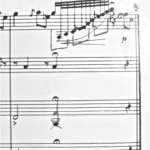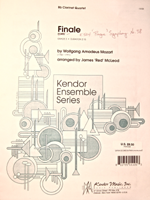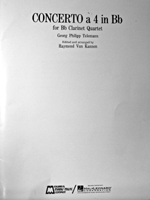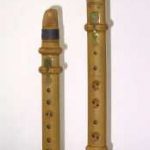Caboodles of Clarinets, Quartets, Vol. 2
These quartets for four B♭ clarinets are appropriate for advanced clarinetists and also work well for casual classical gigs, sight-reading and adult amateurs. All of the selections are excellent arrangements for clarinet quartet and present some entertaining technical challenges. Complete publishing information can be found below.
Tracks for each piece below are available separately as high-quality mp3 files.
Or, download the entire set (single zip file): Clarinet-Quartets-Vol.-2
Chaminade, Cecile: Dance Creole for Clarinet Quartette, transcription by John DeBueris; Warner Bros, ENS00086
Composer Highlights
Practice Suggestions

The original piano version has the 16th notes at the end of mm. 18, 26 and 28 doubled an octave below. I put those in the 3rd part and in mm. 20 & 28, then gave the 2nd part the ‘g’ and ‘f’ eighth notes (an octave higher) that are in the 3rd part. One more small change: pickup to m. 13 to the downbeat of m. 14, 2nd part – down an octave, then in m. 14, half note throat ‘g’ instead of ‘c’; mm. 13, 3rd part, counts 3 & 4: ‘b’ natural and thumb ‘f’ quarter notes, m. 14 ‘e-flat’ half note instead of ‘g’; 4th part, m. 13, counts 3 & 4: low ‘f’ and ‘a-flat’, m. 14 low ‘g’ half note instead of ‘e-flat’. If you change an arrangement for contest, just make sure that the judge has a score clearly marked with the changes and check that it is copacetic with your state’s rulebook concerning adjustments to arrangements. Reasonably, if you are changing a note or articulation, etc., to be true to the original, the judges should be supportive.There are a couple of tuning places that are critical. Spend time as an ensemble tuning the octaves and unisons throughout. In m. 33 I also changed the 3rd part fermata note at the D.S. to a thumb ‘f’.
Download Tracks
01-Chaminade Dance Creole for Clarinet Quartette complete version
02-Chaminade Dance Creole for Clarinet Quartette minus 1st part
03-Chaminade Dance Creole for Clarinet Quartette minus 2nd part
04-Chaminade Dance Creole for Clarinet Quartette minus 3rd part
05-Chaminade Dance Creole for Clarinet Quartette minus 4th part
Download all five tracks (single zip file)
Mozart, W.A.; McLeod, James ‘Red’, arranger; Finale (K385); Kendor Music, 15105
Composer Highlights
2) choose the ‘+’ sign next to Series IV: Orchestral Works
3) choose the quarter not icon to the right of NMA IV/11/8: Duos and Trios for Strings and Woodwind Instruments
4) enter 104 in the ‘find page no.’ box. Here’s the website.
Practice Suggestions
Download Tracks
06-Mozart Finale K385 for Clarinet Quartet complete version
07-Mozart Finale K385 for Clarinet Quartet minus 1st part
08-Mozart Finale K385 for Clarinet Quartet minus 2nd part
09-Mozart Finale K385 for Clarinet Quartet minus 3rd part
10-Mozart Finale K385 for Clarinet Quartet minus 4th part
Download all five tracks (single zip file)
Telemann, Georg Philipp, Concerto à 4 in Bb for Bb Clarinet Quartet; Marks Music/Hal Leonard, HL00008327
Composer Highlights
Georg Philipp Telemann (1681-1767) was an enormously energetic and influential composer in the 18th century. According to his contemporaries, Telemann was considered to be equal to J.S. Bach and G.F. Handel in terms of accomplishment and skill as a composer. Telemann wrote prolifically throughout his life – he composed his first opera at age 12 and church cantatas in his 83rd year. Between those milestones are hundreds of vocal and instrumental works for every conceivable combination and occasion. Some unusual ones include music for birthdays, ‘Captain’s Music’ (Kapitänsmusiken), and music for the institutions of priests. There are a couple of curiosities that I found concerning Telemann’s life story. First of all, he wrote three autobiographies, at ages 37, 48 and 59, so apparently he was quite aware of his own future significance in an historical context. The second story of young Georg Philipp is that he was a chalumeau player. The chalumeau was the predecessor of the clarinet and when Telemann was quite young, after that first opera, his mother and her “advisors” (Georg’s dad had died when Georg was 4) decided that GP was much too interested in music and forbade him from playing or composing. He took his music making underground and it’s quite possible that among those instruments he smuggled away to his secret hiding place was the chalumeau. He had a lifelong appreciation of the little creature, putting it in cantatas and operas even after the clarinet had been accepted as the more sophisticated replacement. How he used the chalemeau parts I found even more telling. Telemann chose to score pairs of chalumeau as the background to bittersweet love scenes, such was his love for the little instrument. Here’s a photo of a chalumeau, so you can imagine a 12 year old Georg surreptitiously wailing away on it in the 1690s!
Telemann wrote some delightful works that I use in performance and teaching. Among these are the flute sonatas, the fantasies and his canonic duets, all of which are arranged for different woodwind instruments. I appreciate Telemann’s combination of the German style (contrapuntal, independent lines in a sort of conversation, as this quartet exemplifies) and the galant style, which might be simply described as having a more melodic and pleasing, less complicated and dense character.
Practice Suggestions
This work is originally the Concerto in D Major, TWV 40:202 for Four Violins without basso continuo. There is a wonderful model recording on iTunes: Telemann: Sinfonia Spirituosa & String Concertos by Musica Antiqua Köln & Reinhard Goebel. I recorded slightly different tempos in all the movements than those printed, but as you will hear in the violin version, not as fast as the string players performed (fast movements, about 123 for mvt. 1 and 132 for mvt. 3). If your quartet (and I mean all members of the quartet) can articulate cleanly at a faster tempo, then perhaps you might consider it. However, being accurate and clean is always preferred to fast. It is much easier for string players to play faster than clarinet players, so don’t sweat the faster tempos.
Movement I: It is important to have the opening feel full of gravitas (gravity, seriousness, pompous, knitted brows, you know what I mean). For this I felt the Adagio needed a slower tempo than the 48 marking and with a dramatic ritardando at the end. I used the score when recording the opening Adagio and marked every major third with a down arrow and the one minor third with an up arrow. All the octaves I played on the money and the 5ths slightly high. Hopefully it sounds in tune to you! The Allegro section must feature the clarinetist playing the sixteenth notes prominently and the piano eighth notes supportively, so make a big deal out of the dynamics. By the way, there is a forte marking missing in the 1st part, m. 15, beat 1. There are other mistakes in the parts, so check the score, as it is correct.
Movement II: I do enjoy this movement, just for the challenge of phrasing the lines in a way that imitates how violinists might, but also staying true to what expressive elements clarinetists possess naturally. I found a somewhat faster tempo works, so I used a half note at 46 for this one. Slow tempos are very personal decisions musically, so try out different ones until it feels right to everyone.
Movement III: Whatever tempo you take, remember that the musical rhythm should have an ‘in-two’ feel. Throughout this contrapuntal texture, one part is prominent and the other three are supportive. Because of this, pay close attention to the dynamics and emphasize the contrast. I added some loud notes to emphasize the inherent duple character in the sections, mm. 14-17 and 38-40 on the supporting quarter notes. There are incorrect notes in the 2nd part, m. 39. The second and third notes, the sixteenths, should be written ‘c’ and ‘b’, not ‘d’ and ‘c’. In the recording I referred to above by the Musica Antiqua Köln, their third movement (the second movement of the clarinet arrangement) is closer to the original, as it is printed in the inside back cover of the clarinet quartet score. As you might have guessed, this is one of those Baroque slow movements, rich with embellishment possibilities. (See my Corelli Adagio, in the Flute Trios, Vol. 1 for some ideas on Baroque ornamentation.) I would suggest that you transcribe some of the ornamentations by Musica Antiqua Köln and play the original version, just for fun and as a good ear-training practice, or, if the contest judges would be open to hearing that version, for your contest performance. (I’ve recorded Mr. Vun Kannon’s version, since that’s the version for which I paid the royalties.)
Download Tracks
11-Telemann Concerto a 4 in Bb for Bb Clarinets I Adagio Allegro complete version
12-Telemann Concerto a 4 in Bb for Bb Clarinets I Adagio Allegro minus 1st part
13-Telemann Concerto a 4 in Bb for Bb Clarinets I Adagio Allegro minus 2nd part
14-Telemann Concerto a 4 in Bb for Bb Clarinets I Adagio Allegro minus 3rd part
15-Telemann Concerto a 4 in Bb for Bb Clarinets I Adagio Allegro minus 4th part
16-Telemann Concerto a 4 in Bb for Bb Clarinets II Grave complete version
17-Telemann Concerto a 4 in Bb for Bb Clarinets II Grave minus 1st part
18-Telemann Concerto a 4 in Bb for Bb Clarinets II Grave minus 2nd part
19-Telemann Concerto a 4 in Bb for Bb Clarinets II Grave minus 3rd part
20-Telemann Concerto a 4 in Bb for Bb Clarinets II Grave minus 4th part
21-Telemann Concerto a 4 in Bb for Bb Clarinets III Allegro complete version
22-Telemann Concerto a 4 in Bb for Bb Clarinets III Allegro minus 1st part
23-Telemann Concerto a 4 in Bb for Bb Clarinets III Allegro minus 2nd part
24-Telemann Concerto a 4 in Bb for Bb Clarinets III Allegro minus 3rd part
25-Telemann Concerto a 4 in Bb for Bb Clarinets III Allegro minus 4th part
Download all fifteen tracks (single zip file)





